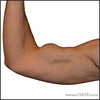Orthopedics Flashcards
(90 cards)
What is arthrodesis?
Fusion
Adjacent joint surfaces are excised to promote bone healing
What is myelopathy?
abnormal condition of spinal cord
What is varus? Valgus?
- Varus
- adduction of distal bone in relation to proximal partner
- Bowleg deformity
- Valgus
- abduction of distal bone
- Knock-knee deformity

What is spondylolithesis?
Slippage of one vertebra on the one below it
What is Kienboch’s Disease?
vascular necrosis of the lunate
Acute Compartment Syndrome
- Cause
- Result
- Common locations
- Cause
- Trauma
- fracture
- Acute increase in exercise
- Trauma
- Result:
- Increased Intercompartmental pressure
- obstructs blood flow
- Can damage nerves and muscles
- Increased Intercompartmental pressure
- Common locations:
- Volar aspect of forearm
- Anterior compartment of leg
Acute Compartment Syndrome
- Signs and Symptoms
- Diagnosis
- Signs and Symptoms
- Three P’s
- Pain
- Paresthesia
- Paralysis
- Tightness of compartment
- Pain with passive stretching of mm
- Inability to contract muscles of compartment
- Three P’s
- Diagnosis
- PE
- Pressure measurement of compartment
- diastolic P - compartment P < 20 mmHg
What does pulselessness in a patient with suspected acute compartment syndrome indicate?
That it is NOT compartment syndrome!
It is an arterial injury
What is the most common bone tumor in patients over 40 y/o?
Metastatic!
- Lung
- Breast
- Prostate
- Thyroid
- Renal
Cumulative Trauma Disorder
- Cause
- Symptoms
- Cause
- Etiology unknown
- aggravated by repetitive motion or sustained exertion
- Symptoms
- Pain
- Fatigue
- Numbness
- Tenosynovitis
- Epicondylitis
Fibromyalgia
- Cause
- Symptoms
- Diagnosis
- Cause
- etiology unknown
- Symptoms
- Muscular pain
- Fatigue
- Stiffness
- Multiple tender points
- Diagnosis
- Widespread pain
- longer than 3 mo
- Multiple trigger points
- Normal joints and x-ray
- Widespread pain
Torus fracture
- Damage
- Population
- Damage
- one side of cortex only
- “buckle” or “wrinkle” frcture
- Population
- Young

Greenstick fracture
- Damage
- Population
- Damage
- Break one side of cortex
- Bend the other
- Population
- Young

What does the Salter Harris Classification scale measure?
Severity of epithyseal fractures
What is a cominuted fracture?
Bone is in more than one piece
What is a segmental fracture?
Segment broken off of a bone
What bone abnormalities are common in Osteoporosis?
- Fractures
- Hip
- Wrist
- Compression
- Kyphosis
What bone process is abnormal in Osteomalacia? What is the result?
- Abnormal Osteoblastic process
- Soft bone
Reflex Sympathetic Dystrophy
- Symptoms
- Common location
- Stage at which it is irreversible
- Symptoms
- Severe pain
- Swelling
- Discoloration
- Excessive perspiration
- Common location
- Upper extremity
- Stage at which it is irreversible
- 8-9 mo (stage 3)
Falling on the tip of the shoulder results in what type of injury?
Acromioclavicular
What complication should be concidered when fracture of the scapula occurs?
Pulmonary Contusion
What are the characteristics of Adhesive Capsulitis (Frozen Shoulder)? How long does it take to heal?
- Characteristics
- Insidious onset
- Decreased range of motion
- Pain
- Time to heal
- 2 years
What is the therapy for a shoulder dislocation?
- Strengthening of subscapularis and infraspinatus
- Immobilize for 2-3 weeks
What can present with subacromial pain that radiates into the brachium with weakness and catching with elevation?
- Bursitis
- Impingement
- Rotator Cuff Tear
- may need more aggressive therapy than the rest




















